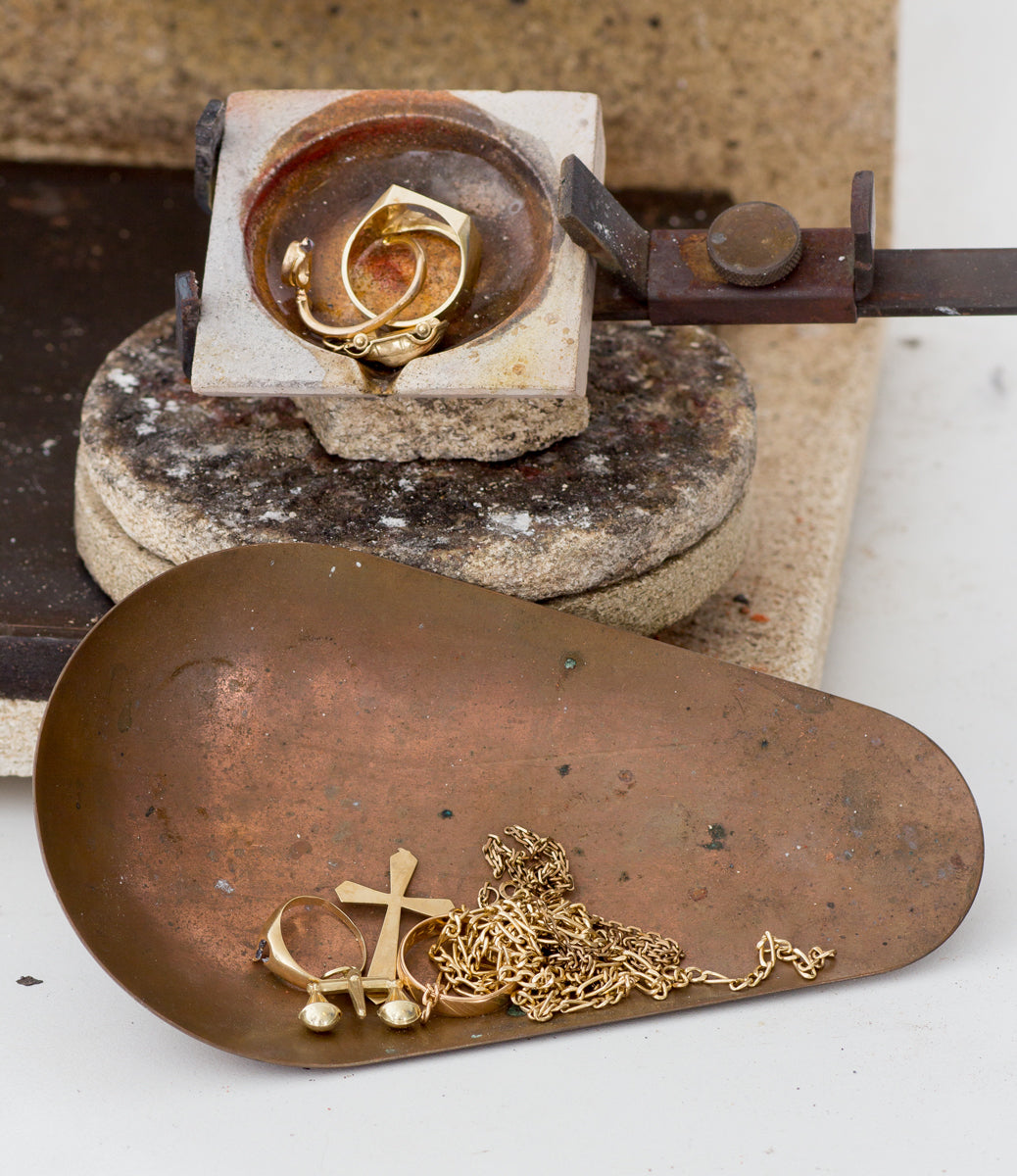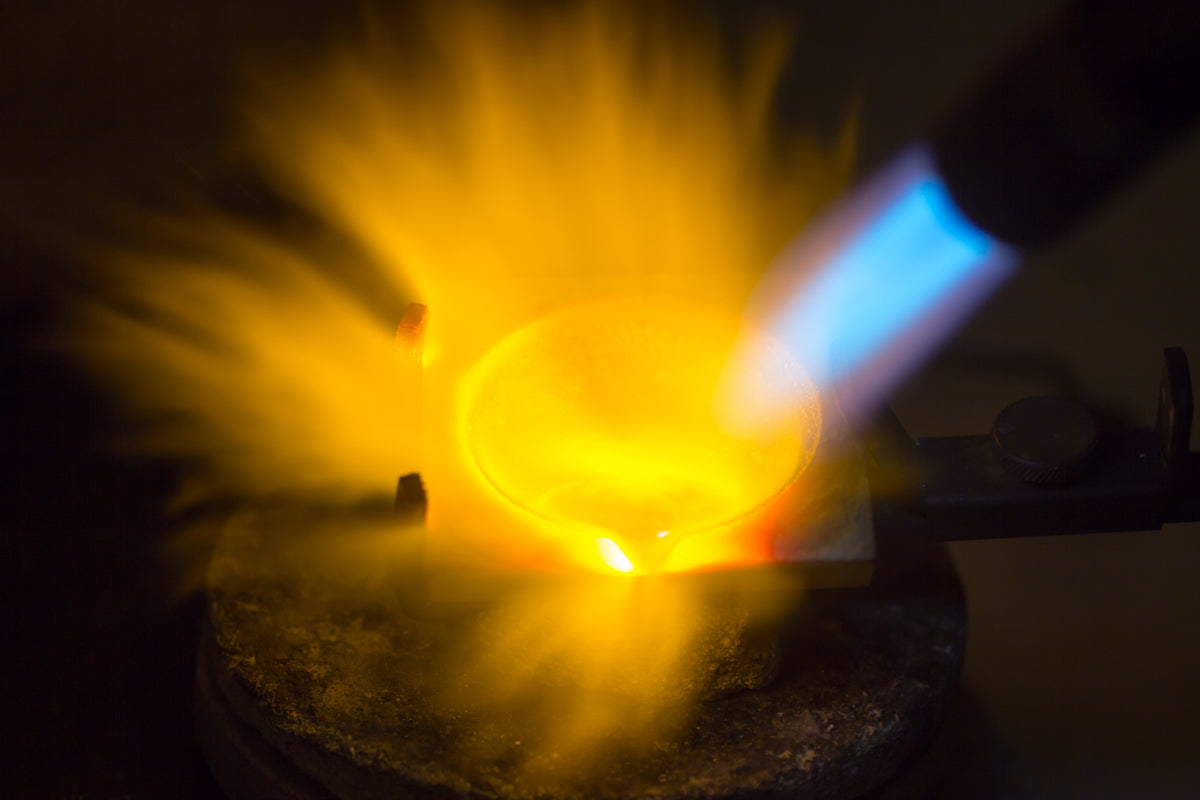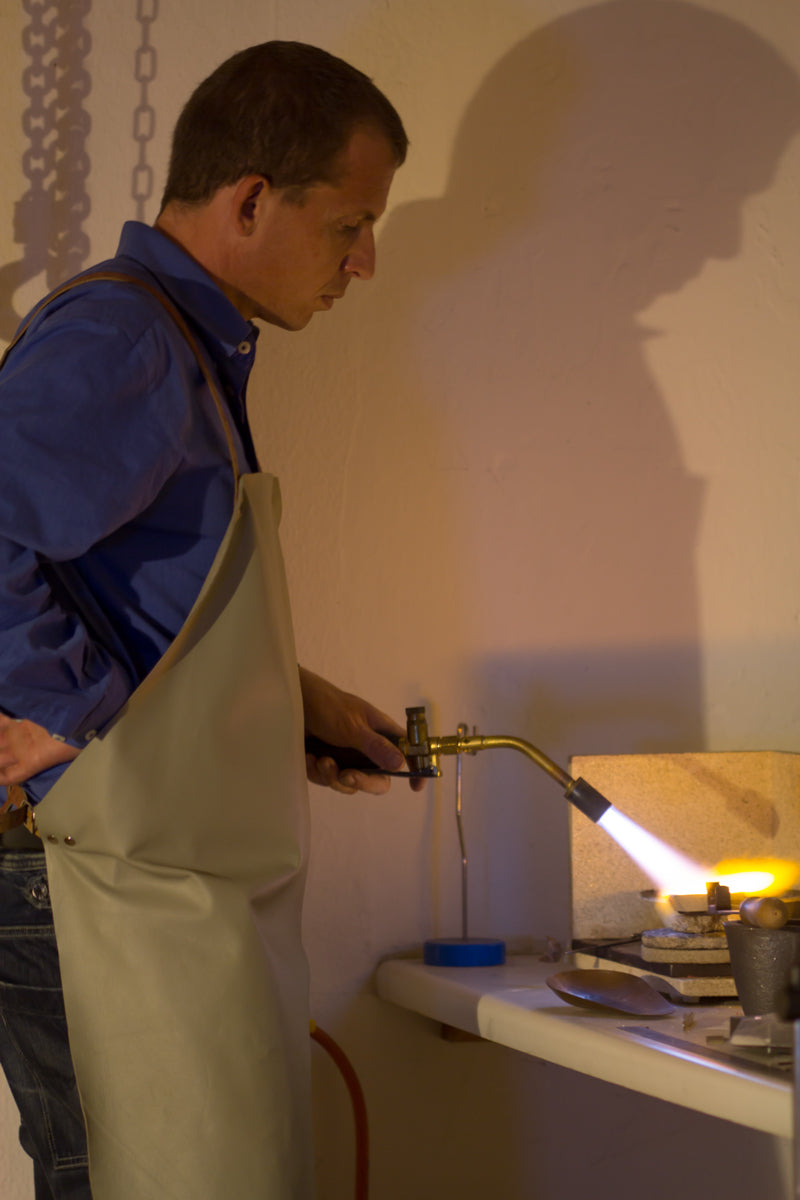Goldsmith workshop
From raw material to finished piece of jewellery
On these pages we will give you an insight into the different steps we take to create a piece of jewellery for you by hand.
The Melting
Melting is the process of transforming a solid material from its solid state to its liquid state by applying heat.
In our workshop, we melt the required metal in a crucible using a melting gun. The melting gun uses propane gas to reach temperatures of around 1100°C, which is required to melt fine gold, for example.
The molten metal is then poured into a wire or sheet casting, depending on its intended use. For other shapes, such as piercing balls, we use processes such as sand casting, sepia casting or centrifugal casting, depending on the type of shape.
The production of wire and sheet
Once the molten metal has been poured into a sheet or wire casting, it can be further processed into sheet or wire of the desired dimensions after quenching in water, tapping or sawing off the casting head. Before rolling, the blank should be preforged on the anvil.
Rolling is a continuous or stepwise pressure forming process using one or more rotating tools (rolls).
Plate rolling consists of a pair of hardened steel rolls mounted on a base frame. Power is transmitted to the rolls by gears. Rolling of sheet metal must be gradual. The tension created in the metal during rolling is eliminated by intermediate annealing.
Wire rolls are also operated by hand. They are similar in construction to the sheet rolls, but the pair of rolls has opposing obtuse-square grooves that become smaller as the roll progresses. Once the wire has been rolled to the desired thickness, it is annealed, filed to a point and can then be drawn to the required thickness using the drawing die. The drawing dies are hardened steel plates with round, semicircular, square, triangular, knife-shaped and oval openings that become smaller as the process progresses. They can be used to produce round, semi-circular, square, triangular, knife and oval wires.
Soldering
Brazing is probably the most important manufacturing technique in the precious metals industry. Soldering is used to join individual workpieces together. This is the only way to create a complete, constructed piece of jewellery. Depending on the working temperature, a distinction is made between soft soldering (below 450°C) and hard soldering (above 450°C). In the goldsmith's workshop, only soldering is important. Brazed joints are inseparable joints. The bond between the parts to be brazed is based on the formation of leagues at the interfaces of the joint in the case of parts that form alloys with the brazing alloy.
A very elaborate piece of jewellery where a lot of soldering was used is the necklace of the O.
Chasing (from the French ciseler = to chase)
Chasing is a chipless working of metal, mainly by means of different shaped punches.
Chasing is done with a chasing hammer, the head of which is shaped into a ball punch on one side and a finishing surface on the other. The handle ends in a club-like bulge that fits the curved palm of the hand and also acts as a counterweight to the metal head. Flat objects to be chased are cemented onto the so-called chasing ball.
The shape of the mallet is determined by the shape of the desired chasing. For example, a ball punch is used for semi-circular shapes, as can be seen in the pearl shell piercing.
Grinding and polishing
Grinding
Grinding is a machining process in which material is removed by a large number of hard crystals (abrasive grains) of indeterminate geometry.
After filing and grinding, fine ridges are still visible on the surface. These last irregularities are attempted to be smoothed by grinding.
Polishing
When polishing, no material should be removed from the surface. The polishing effect is caused by the fact that the pressure of the polishing wheels and the polishing material generates a considerable amount of heat, which can even liquefy parts of the metal surface, forming a skin of tiny elementary particles of a crystalline nature.
On these pages we will give you an insight into the different steps we take to create a piece of jewellery for you by hand.
The Melting
Melting is the process of transforming a solid material from its solid state to its liquid state by applying heat.
In our workshop, we melt the required metal in a crucible using a melting gun. The melting gun uses propane gas to reach temperatures of around 1100°C, which is required to melt fine gold, for example.
The molten metal is then poured into a wire or sheet casting, depending on its intended use. For other shapes, such as piercing balls, we use processes such as sand casting, sepia casting or centrifugal casting, depending on the type of shape.
The production of wire and sheet
Once the molten metal has been poured into a sheet or wire casting, it can be further processed into sheet or wire of the desired dimensions after quenching in water, tapping or sawing off the casting head. Before rolling, the blank should be preforged on the anvil.
Rolling is a continuous or stepwise pressure forming process using one or more rotating tools (rolls).
Plate rolling consists of a pair of hardened steel rolls mounted on a base frame. Power is transmitted to the rolls by gears. Rolling of sheet metal must be gradual. The tension created in the metal during rolling is eliminated by intermediate annealing.
Wire rolls are also operated by hand. They are similar in construction to the sheet rolls, but the pair of rolls has opposing obtuse-square grooves that become smaller as the roll progresses. Once the wire has been rolled to the desired thickness, it is annealed, filed to a point and can then be drawn to the required thickness using the drawing die. The drawing dies are hardened steel plates with round, semicircular, square, triangular, knife-shaped and oval openings that become smaller as the process progresses. They can be used to produce round, semi-circular, square, triangular, knife and oval wires.
Soldering
Brazing is probably the most important manufacturing technique in the precious metals industry. Soldering is used to join individual workpieces together. This is the only way to create a complete, constructed piece of jewellery. Depending on the working temperature, a distinction is made between soft soldering (below 450°C) and hard soldering (above 450°C). In the goldsmith's workshop, only soldering is important. Brazed joints are inseparable joints. The bond between the parts to be brazed is based on the formation of leagues at the interfaces of the joint in the case of parts that form alloys with the brazing alloy.
A very elaborate piece of jewellery where a lot of soldering was used is the necklace of the O.
Chasing (from the French ciseler = to chase)
Chasing is a chipless working of metal, mainly by means of different shaped punches.
Chasing is done with a chasing hammer, the head of which is shaped into a ball punch on one side and a finishing surface on the other. The handle ends in a club-like bulge that fits the curved palm of the hand and also acts as a counterweight to the metal head. Flat objects to be chased are cemented onto the so-called chasing ball.
The shape of the mallet is determined by the shape of the desired chasing. For example, a ball punch is used for semi-circular shapes, as can be seen in the pearl shell piercing.
Grinding and polishing
Grinding
Grinding is a machining process in which material is removed by a large number of hard crystals (abrasive grains) of indeterminate geometry.
After filing and grinding, fine ridges are still visible on the surface. These last irregularities are attempted to be smoothed by grinding.
Polishing
When polishing, no material should be removed from the surface. The polishing effect is caused by the fact that the pressure of the polishing wheels and the polishing material generates a considerable amount of heat, which can even liquefy parts of the metal surface, forming a skin of tiny elementary particles of a crystalline nature.



